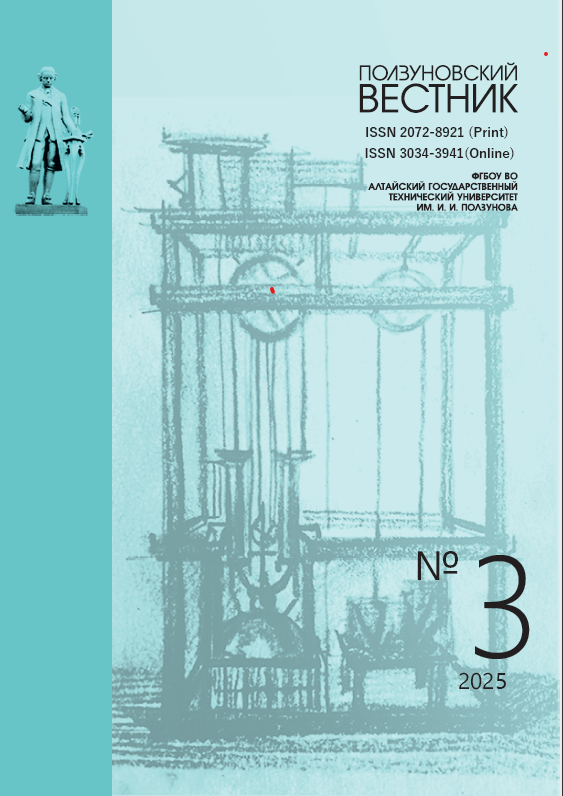ANALYSIS OF THE COMPOSITION OF FRACTIONS OF PYROLYSIS LIQUID OF PLANT BIOMASS
VREEAJ
DOI:
https://doi.org/10.25712/ASTU.2072-8921.2025.03.030Keywords:
bio-oil; fast pyrolysis; wood waste; bio-oil distillation, bio-oil extractionAbstract
The article presents the results of a study on the multi-component composition of the liquid product derived from the pyrolysis of wood waste (bio-oil). Based on gas chromatography data, the authors found that the pyrolysis liquid product (PLP) contains a multitude of compounds, including water and acids, with acetic acid being the predominant one. The article describes the bio-oil separation process, which consists of three stages. The feedstock for pyrolysis was wood waste from various tree species. The yield of the liquid product was 54%, of which 85% is the water-soluble fraction and 15% is the water-insoluble fraction. Fractionation stages included vacuum distillation, water extraction, and n-hexane extraction. The conditions for conducting all separation stages are described. The chemical composition of each obtained fraction was determined. It was established that during distillation, the main portion of acetic acid, along with water, transitions to the condensate. Further water extraction allows for the isolation of water-soluble organic compounds, with special attention given to D-allulose, which exhibits inhibitory effects on certain malignant formations and is used as a low-calorie sweetener. The third stage of the study, utilizing n-hexane as a non-polar organic solvent, led to the discovery of previously unreported high-molecular compounds, such as stigmasterol, squalene, and phenanthrene compounds. As a result of the research, a significant amount of phenolic compounds was found in the bio-oil, while fractionation decreased the proportion of acidic and high-molecular condensed compounds in the raw bio-oil, thereby enhancing its potential use as a phenol-replacing and fuel raw material.
References
Ковалев Ю. Ю. Пять лет Парижскому соглашению: прошлое, настоящее и будущее глобального климатического договора //История и современное мировоззрение. 2021.№. 1. С. 20-29.
Oochit D., Selvarajoo A., Arumugasamy S. K. Pyrolysis of biomass //Waste biomass management–a holistic approach. 2017. С. 215-229.
Dhyani V., Bhaskar T. Pyrolysis of biomass //Biofuels: alternative feedstocks and conversion processes for the production of liquid and gaseous biofuels. – Academic Press, 2019. С. 217-244.
Neves D. et al. Characterization and prediction of biomass pyrolysis products //Progress in energy and combustion Science. 2011. Т. 37. №. 5. С. 611-630.
Shafizadeh F. Introduction to pyrolysis of biomass //Journal of analytical and applied pyrolysis. 1982. Т. 3. №. 4. С. 283-305.
Shafizadeh F. Pyrolysis and combustion of cellulosic materials //Advances in carbohydrate chemistry. – Academic press, 1968. Т. 23. С. 419-474.
Graham R. G., Bergougnou M. A., Overend R. P. Fast pyrolysis of biomass //Journal of analytical and applied pyrolysis. 1984. Т. 6. №. 2. С. 95-135.
Lindfors C. et al. Fractionation of bio-oil //Energy & fuels. 2014. Т. 28. №. 9. С. 5785-5791.
Kwon K. C. et al. Catalytic deoxygenation of liquid biomass for hydrocarbon fuels //Renewable Energy. 2011. Т. 36. №. 3. С. 907-915.
Choudhary T. V., Phillips C. B. Renewable fuels via catalytic hydrodeoxygenation //Applied Catalysis A: General. 2011. Т. 397. №. 1-2. С. 1-12.
Wang S. et al. Bio-gasoline production from co-cracking of hydroxypropanone and ethanol //Fuel processing technology. 2013. Т. 111. С. 86-93.
Trane R. et al. Catalytic steam reforming of bio-oil //International journal of hydrogen energy. 2012. Т. 37. №. 8. С. 6447-6472.
Zhao C. et al. Hydrodeoxygenation of bio-derived phenols to hydrocarbons using RANEY® Ni and Nafion/SiO 2 catalysts //Chemical Communications. 2010. Т. 46. №. 3. С. 412-414.
Guo Z. et al. Separation characteristics of biomass pyrolysis oil in molecular distillation //Separation and Purification Technology. 2010. Т. 76. №. 1. С. 52-57.
Vitasari C. R., Meindersma G. W., De Haan A. B. Water extraction of pyrolysis oil: The first step for the recovery of renewable chemicals //Bioresource technology. 2011. Т. 102. №. 14. С. 7204-7210.
Toledano A. et al. Lignin separation and fractionation by ultrafiltration //Separation and Purification Technology. 2010. Т. 71. №. 1. С. 38-43.
Wang S. et al. Multi-step separation of monophenols and pyrolytic lignins from the water-insoluble phase of bio-oil //Separation and Purification Technology. 2014. Т. 122. С. 248-255.
Электронный ресурс. https://energolesprom.ru/tehnologiya/ (дата обращения 20.08.2024)
Neutrals influence on the water resistance coefficient of phenol-formaldehyde resin modified by wood pyrolysis liquid products / S. Zabelkin, A. Valeeva, A. Sabirzyanova [et al.] // Biomass Conversion and Biorefinery. 2020. DOI 10.1007/s13399-020-01025-0. EDN QLOXXE.
Синтез и свойства фенолоформальдегидных смол из продуктов термической переработки древесины / А. И. Валиуллина, А. Н. Грачев, А. Р. Валеева [и др.] // Клеи. Герметики. Технологии. 2022. № 5. С. 2-11. DOI 10.31044/1813-7008-2022-0-5-2-111. – EDN MWDHDK.
Валеева, А. Р. Применение жидких продуктов быстрого пиролиза древесных отходов в качестве компонента фенолоформальдегидных смол : специальность 05.21.03 "Технология и оборудование химической переработки биомассы дерева; химия древесины" : диссертация на соискание ученой степени кандидата технических наук / Валеева Айгуль Раисовна, 2022. 155 с. EDN KNFXVS.
Валеева А. Р. и др. Влияние способов предпосевной обработки семян пшеницы уксусной фракцией жидких продуктов пиролиза древесины на всхожесть, длину корней и интенсивность роста //Известия Санкт-Петербургской лесотехнической академии. 2024. №. 245. С. 275-292.
Koltsova T. G. et al. Phytotesting of Liquid Products of Wood Pyrolysis on Seeds of Higher Plants //Waste and Biomass Valorization. 2024. С. 1-13.
Kanaji N. et al. Additive antitumour effect of D allose in combination with cisplatin in non-small cell lung cancer cells //Oncology Reports. 2018. Т. 39. №. 3. С. 1292-1298.
Yamaguchi F. et al. Rare sugar D-allose enhances anti-tumor effect of 5-fluorouracil on the human hepatocellular carcinoma cell line HuH-7 //Journal of bioscience and bioengineering. – 2008. Т. 106. №. 3. С. 248-252.
Mu W. et al. Recent advances on applications and biotechnological production of D-psicose //Applied Microbiology and Biotechnology. 2012. Т. 94. С. 1461-1467.
Downloads
Published
How to Cite
Issue
Section
License
Copyright (c) 2025 Aigul R. Valeeva

This work is licensed under a Creative Commons Attribution 4.0 International License.















 .
. This work is licensed under a
This work is licensed under a 
